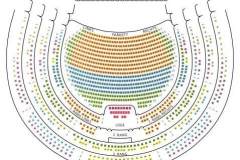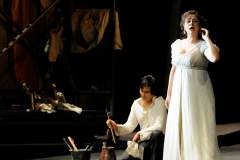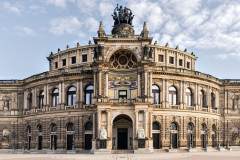Tosca
Mo | Tu | We | Th | Fr | Sa | Su |
Tosca - Giacomo Puccini
Melodramma in three acts
Libretto by Giuseppe Giacosa and Luigi Illica after Victorien Sardou's drama of the same name
Performed in Italien with German and English supertitles
Premiere: January 31, 2009
Pure drama: a life dedicated to art is destroyed by jealousy and greed.
Storyline
First Act
In the Church, in the Morning
Cesare Angelotti, the former consul of the Roman Republic, has escaped from imprisonment by the new rulers. His first place of refuge is the family chapel of his sister, the Marchesa Attavanti. The Marchesa has hidden clothing there so that he can continue his flight unrecognised. The Sacristan is giving the painter Mario Cavaradossi a meal. Looking at the painting of Mary Magdalene on a fresco, he recognises the Marchesa, whom he has often come across praying in the church.
Cavaradossi compares her inspirational beauty with that of his beloved Tosca, the loveliest singer in Rome. The painter sees it as the inspirational creation of a work of art, but for the Sacristan it is the heretical lustfulness of a Republican, for whom nothing is sacred. When the church grows quiet again, Angelotti ventures out. Cavaradossi recognises him and offers him his support. Tosca demands entry to the church. She is outraged at having to stand in front of a closed door, hearing Cavaradossi’s voice coming from inside. It can mean but one thing: unfaithfulness. Angelotti hides again. Cavaradossi assuages her jealous suspicions that he has a secret lover. They arrange to meet that evening. Cannons fired from the Castel Sant’Angelo signal that the prisoner’s escape has been discovered. Cavaradossi flees with Angelotti to a hiding-place in his villa where he can stay until perhaps managing to escape Rome. The Sacristan returns and reports to the gathering choirboys that the Republicans under Bonaparte have been defeated at the Battle of Marengo. To celebrate the victory, there is to be a Te Deum in the church and a cantata sung by Floria Tosca before the Queen. The Roman police chief, Scarpia, and his men occupy the church. Scarpia elicits evidence from the Sacristan that Angelotti has been at the church and Cavaradossi is involved in his flight. Tosca returns to see Cavaradossi again. With the fan he has found and identified as the property of the Marchesa, Scarpia sends the much-coveted woman into a frenzy of jealousy. Believing she has been cheated by Cavaradossi, she wants to take him to task in his villa. Scarpia sends his agent Spoletta to follow her. During the Te Deum, Scarpia’s desire for Tosca reaches unrestrained heights: he wants to possess Tosca and dispose of Cavaradossi.
Act Two
In the Palazzo, during the Evening
Scarpia’s thoughts are revolving around Tosca and the chance that she will soon surrender to him. Tosca is in the palazzo for the celebrations. He sends for her. Spoletta reports that he has failed to catch Angelotti. Instead, he brings forward Cavaradossi. Scarpia starts to question him, with Tosca heard singing in the background. Cavaradossi denies all the accusations. As the cantata finishes, Tosca follows Scarpia’s order. To her confusion, she finds him with Cavaradossi. Scarpia has him taken into a side room, where he is tortured. Scarpia makes Tosca’s love for and worry about Cavaradossi an instrument of his interrogation. He says that she is to blame for her lover’s suffering. The two stand up to him. Finally, Tosca, under the cries of the tortured man, Tosca reveals the hiding-place. Cavaradossi rejects Tosca. News brought by Sciarrone of a defeat at the hands of Bonaparte gives him new strength. He rebukes Scarpia, who has him taken away immediately for execution. Scarpia uses Cavaradossi’s life to put pressure on Tosca. News comes in that Angelotti has committed suicide. Tosca can no longer escape Scarpia’s desire and does a deal with him: he can have her body for one hour if Cavaradossi is given his freedom, by faking the execution, and they can both have safe conduct to escape. Just as Scarpia believes he has achieved his goal, she stabs him. She takes the letter of safe conduct and conducts the last rites on the dead man before rushing to Cavaradossi’s prison.
Act Three
Platform of the Castel Sant’Angelo, at Dawn
A shepherd boy sings a love song. Cavaradossi begs the guard to let him write Tosca a farewell letter. His memories send him into a delirium of happiness. Tosca has Spoletta take her to Cavaradossi. She tells the man she loves about the letter of safe conduct, the fake shooting which is about to happen, and Scarpia’s death. They dream of a wonderful future together. From a distance Tosca watches the execution. She waits impatiently for the soldiers to leave. Left behind, she rushes over to Cavaradossi. He is dead. She realises that Scarpia has deceived her. Scarpia’s murder has been discovered. Tosca is surrounded. She throws herself off the battlements of the Castel Sant’Angelo.
Program and cast
Floria Tosca: Maria Agresta
Mario Cavaradossi: Joseph Calleja
Baron Scarpia: Erwin Schrott (April 5, 10, 12, 2025), Oleksandr Pushniak (April 18, 21, May 1, 2025)
Cesare Angelotti: Aleksei Kulagin
The Sacristan: Magnus Piontek
Spoletta: Aaron Pegram
Sciarrone: Vladyslav Buyalskiy
A Jailor: Mateusz Hoedt
A Shepherd: Dresden Kreuzchor
Musical Direction: Marco Armiliato
Production: Johannes Schaaf
Set: Christof Cremer
Costumes: Petra Reinhardt
Lighting: Jens Klotzsche
Chorus: Jonathan Becker
Children's Chorus: Claudia Sebastian-Bertsch
Dramaturgy: Ilsedore Reinsberg
Saxon State Opera Chorus Dresden
Children's Chorus of Semperoper Dresden
Saxon State Orchestra Dresden
Semperoper Dresden
The Semperoper is the opera house of the Sächsische Staatsoper Dresden (Saxon State Opera) and the concert hall of the Sächsische Staatskapelle Dresden (Saxon State Orchestra). It is also home to the Semperoper ballet. The building is located near the Elbe River in the historic centre of Dresden, Germany.
The opera house was originally built by the architect Gottfried Semper in 1841. After a devastating fire in 1869, the opera house was rebuilt, partly again by Semper, and completed in 1878. The opera house has a long history of premieres, including major works by Richard Wagner and Richard Strauss.
The first opera house at the location of today's Semperoper was built by the architect Gottfried Semper. It opened on 13 April 1841 with an opera by Carl Maria von Weber. The building style itself is debated among many, as it has features that appear in three styles; Early Renaissance and Baroque, with Corinthian style pillars typical of Greek classical revival. Perhaps the most suitable label for this style would be eclecticism, where influences from many styles are used, a practice most common during this period. Nevertheless, the opera building, Semper's first, is regarded as one of the most beautiful European opera houses.

 EN
EN DE
DE IT
IT FR
FR ES
ES RU
RU JP
JP RO
RO
 Seating plan
Seating plan 


